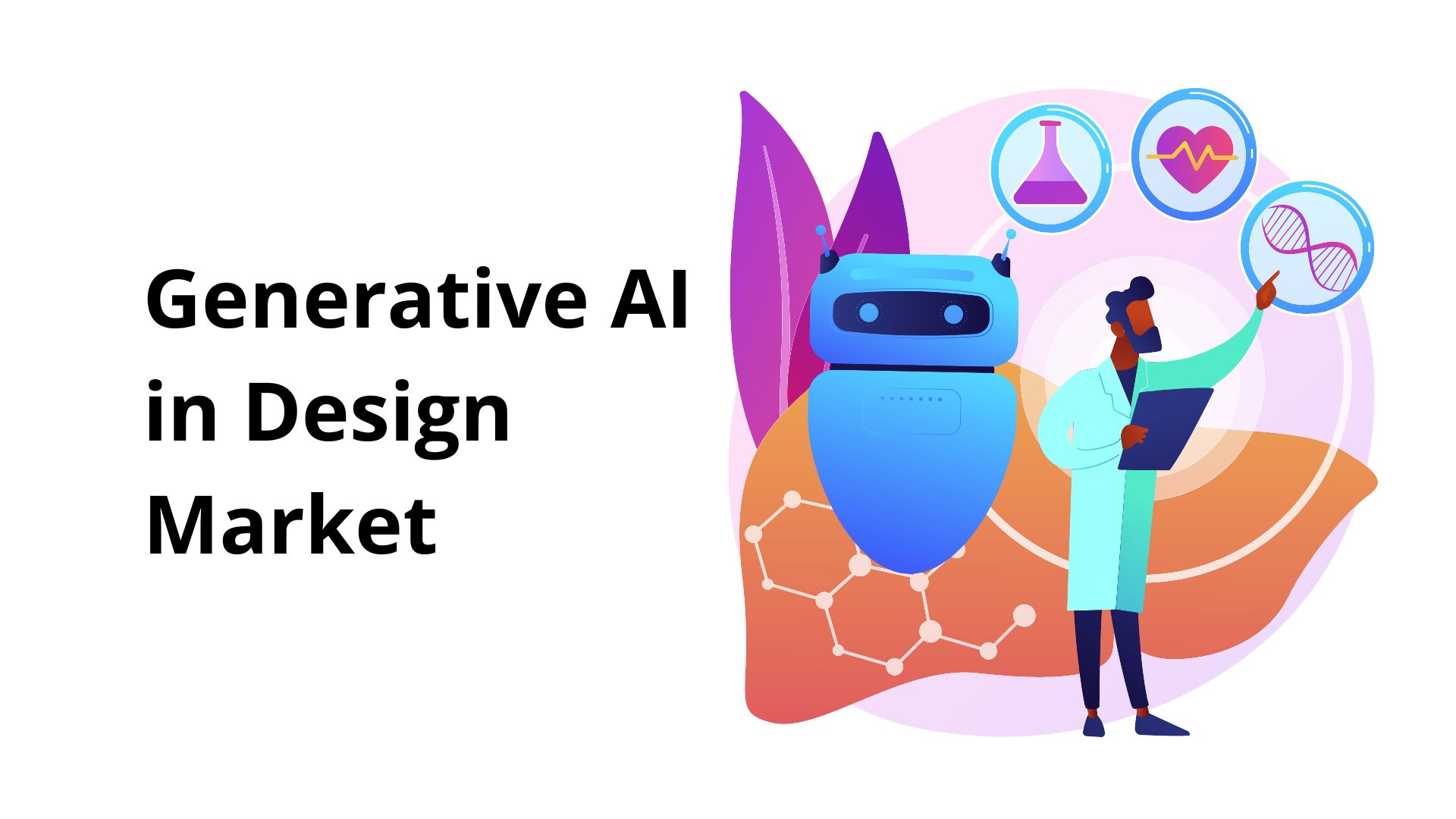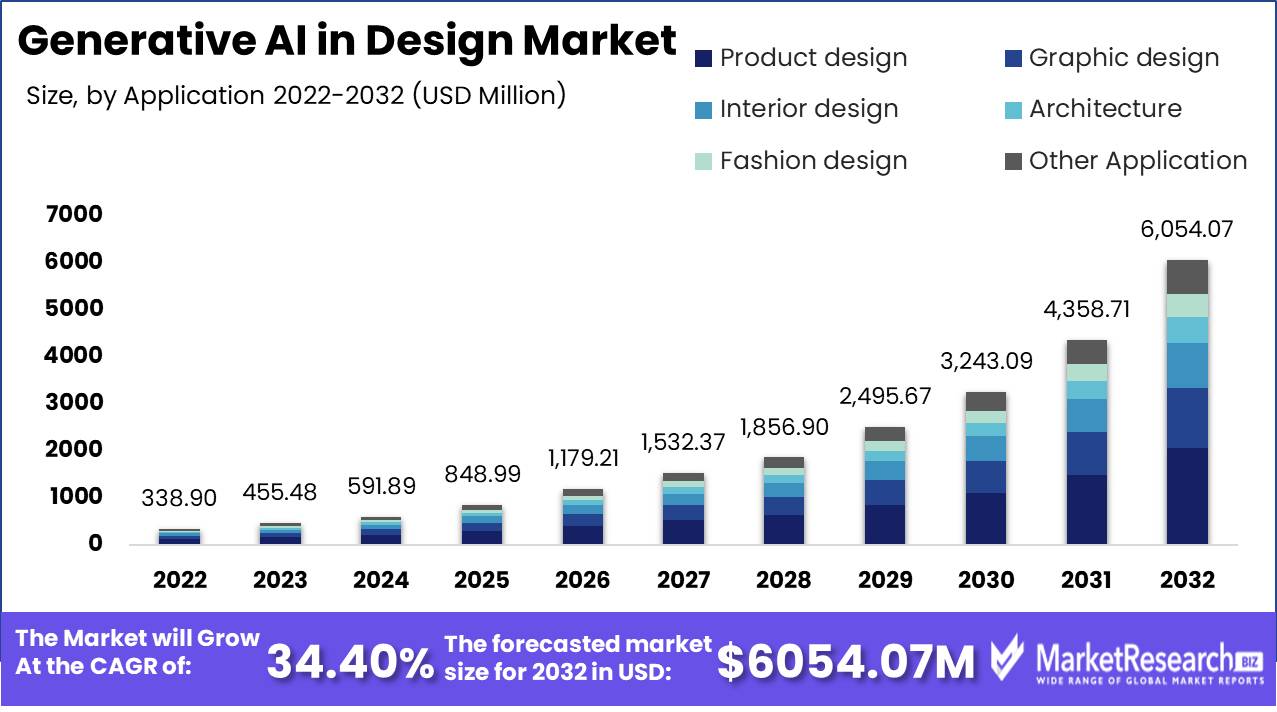Generative AI in Design Market Hit USD 6054.07 Mn by 2032

Page Contents
Market Overview
Published Via 11Press : Generative AI in Design Market size is expected to be worth around USD 6054.07 Mn by 2032 from USD 338.9 Mn in 2022, growing at a CAGR of 34% during the forecast period from 2022 to 2032.
Recent years have witnessed unprecedented expansion and innovation within the generative AI in design market. Thanks to advances in artificial intelligence and machine learning technologies, generative AI is now used by designers from multiple industries as an indispensable resource.
Generative AI design refers to the application of algorithms and data-driven processes to generate designs. Generative AI allows designers to explore vast design potential and generate innovative new concepts by using computation power and automation to explore these options. This technology has found applications across architecture, product design, graphic design, fashion design and many other disciplines.
Generative AI design offers many advantages over its traditional alternatives, including augmenting human creativity. Leveraging large amounts of data and algorithms, designers can quickly generate multiple design variations while exploring aesthetic possibilities that were not possible before. Not only will this save time but it will also challenge traditional design approaches.
Generative AI design technology also enables designers to optimize designs based on specific constraints and objectives. They can input variables like cost, material availability, or performance requirements and have AI algorithms generate designs that meet those criteria – opening up opportunities for designing efficient and sustainable solutions.
The market for generative AI design solutions is experiencing exponential expansion, with both established companies and startups investing heavily in this technology. Major tech players have developed tools and platforms that utilize this AI capability, providing designers with powerful software to enhance their creative processes. Design agencies and consulting firms have begun offering services with integrated generative AI capabilities as they meet rising demand for data-driven design solutions.
Yet there remain numerous barriers to adopting generative AI in design. One key concern is ethical use of AI-generated designs in industries where intellectual property rights are vital. Another major hurdle involves hiring skilled professionals capable of effectively using and interpreting generative AI tools.
Despite these obstacles, the market for generative AI in design remains positive and on an upward trend. As AI technologies progress and become more accessible to designers, more opportunities will arise to utilize generative AI for improved creativity, efficiency, and sustainability in their design processes.
Request Sample Copy of Generative AI in Design Market Report at: https://marketresearch.biz/report/generative-ai-in-design-market/request-sample
Key Takeaways
- Generative AI design enhances creativity by exploring all possible design pathways.
- Saving both time and costs by automating design processes and creating multiple design variations, it provides significant time and cost savings.
- Design optimization can be accomplished using AI algorithms to meet specific constraints and objectives.
- Generative AI provides designers with a way to go beyond conventional design approaches and discover unexplored aesthetic potentials.
- Generative AI for design is experiencing rapid expansion, and many major players are investing in this emerging field.
- Ethical considerations related to AI-generated designs arise, particularly regarding intellectual property rights.
- Skilled professionals who can use generative AI tools are in high demand, emphasizing the need for continued skill development within the design industry.
Regional Snapshot
North America and particularly the United States has long been at the forefront of AI design technology development. Major tech companies are creating AI tools specifically for designers. Design agencies and startups in San Francisco and New York are actively adopting generative AI to enhance their creative processes.
Europe boasts a thriving generative AI in design market. Countries such as Great Britain, Germany and France are seeing increased adoption of AI tools by creative agencies and freelance creative professionals in these countries. European design firms are using this cutting-edge technology to craft groundbreaking products and architectural designs using AI.
The Asia Pacific region, including countries like China, Japan and South Korea are seeing tremendous gains from applying generative AI in design. Designers from these nations are turning to AI-powered tools in order to optimize designs, improve efficiency and meet the rapidly expanding industry demands.
Latin America's market for generative AI design solutions is growing, as more design agencies and creative professionals adopt it. Countries like Brazil and Mexico are witnessing an emergence of startups and innovation hubs offering AI-powered design solutions.
Middle East and Africa countries are quickly adopting AI in design. Countries such as United Arab Emirates and South Africa are using these tools in projects designed to produce sustainable and cost-efficient solutions.
Drivers
Technological Advancements: Rapid advances in artificial intelligence and machine learning technology provide designers with increasingly powerful and sophisticated generative AI tools, allowing them to explore new design possibilities and increase creativity.
Efficiency and Time Savings: Generative AI simplifies design processes by automating them, quickly creating multiple design variations and saving both designers and businesses both time and money in terms of time and costs.
Enhance Design Optimization: Generative AI algorithms can optimize designs based on specific constraints and objectives, such as material availability, cost considerations or performance needs; leading to more efficient and sustainable design solutions.
Personalization Demand Increases: With increasing customer expectations of personalized products and experiences, generative AI allows designers to quickly produce custom designs at scale in various industries to satisfy this growing trend.
Restraints
Ethical Concerns: Generative AI raises ethical considerations that need to be considered when using it, particularly regarding intellectual property rights and ownership of its-generated designs. Questions surrounding who owns them as well as how they should be protected and commercialized represent significant obstacles that need to be resolved in order for this technology to flourish responsibly.
Lack of Skilled Professionals: For effective use of generative AI tools to occur, experienced professionals with knowledge in AI and generative design are necessary for effective use. Unfortunately, due to a shortage of designers and engineers skilled in these disciplines, wider adoption is limited.
Data Quality and Availability: Generative AI relies heavily on accessing high-quality, diverse datasets for optimal results, but finding such resources may prove challenging in certain industries that use proprietary or limited sources for their data sources. Lack of data availability could greatly decrease its efficacy and accuracy as part of an AI application.
Opportunities
Industry-Specific Applications: Generative AI presents opportunities for industry-specific applications in fields like architecture, automobile design, fashion and product design. Each sector can leverage this type of artificial intelligence to address unique challenges while opening up creative possibilities tailored to their own requirements.
Collaborative Design Processes: Generative AI can facilitate collaborative design processes between designers, engineers, and stakeholders by offering an iterative platform for iterative design exploration. This collaborative approach promotes innovation while potentially leading to more comprehensive and optimized designs solutions.
Sustainable Design: Generative AI can contribute to sustainable design practices by optimizing designs for efficiency, material usage and energy consumption. This allows designers to create environmentally-friendly solutions while simultaneously reducing waste and fostering sustainability across various industries.
New Business Models and Services: Generative AI opens up opportunities for innovative business models and services within the design industry. Design agencies can use Generative AI-powered design services, consultancy or to develop and sell Generative AI platforms or tools as additional revenue streams while expanding their market presence.
Take a look at the PDF sample of this report: https://marketresearch.biz/report/generative-ai-in-design-market/request-sample
Challenges
Interpretation and Evaluation: Interpreting and assessing the results generated by generative AI tools can be challenging. Designers need to assess their relevance, feasibility, aesthetic qualities and ensure they meet project requirements while adhering to human-centric design principles.
Bias and Fairness: Generative AI systems may unintentionally perpetuate any bias present in their training data, leading to biased design outputs. Addressing bias and ensuring fairness when designing with AI requires careful data curation and algorithmic considerations.
Adoption and Resistance: Implementing generative AI into design may face resistance from both designers and stakeholders who may be uncertain how AI algorithms should be utilized for creative processes. Overcoming such resistance requires education and change management techniques in order to foster an environment open to AI use in design.
Continuous Learning and Upgrading (CL&U): AI technology is constantly developing and designers must remain up-to-date with its latest advancements, algorithms, and best practices in order to effectively utilize generative AI tools. Staying abreast of developments requires constant training and professional development initiatives as part of an ongoing professional growth program.
Market Segmentation
Based on Application
- Product design
- Graphic design
- Interior design
- Architecture
- Fashion design
- Other Application
Based on End-Users
- Large enterprises
- Small and medium-sized enterprises (SMEs)
- Individual users
Key Players
- Autodesk inc.
- Adobe Inc.
- Google LLC
- IBM Corporation
- Microsoft Corporation
- Nvidia Corporation
- OpenAI
- Dassault Systèmes SE
- Siemens
- Bentley Systems
- Other Key Players
Report Scope
| Report Attribute | Details |
| Market size value in 2022 | USD 338.9 Mn |
| Revenue Forecast by 2032 | USD 6054.07 Mn |
| Growth Rate | CAGR Of 34% |
| Regions Covered | North America, Europe, Asia Pacific, Latin America, and Middle East & Africa, and Rest of the World |
| Historical Years | 2017-2022 |
| Base Year | 2022 |
| Estimated Year | 2023 |
| Short-Term Projection Year | 2028 |
| Long-Term Projected Year | 2032 |
Recent Developments
- The year 2023 is the date Nvidia just announced the Omniverse platform that is an AI-powered design and collaboration tool. Omniverse allows designers to collaborate on real-time large-scale projects, and provides a variety of new AI tools for creating innovative modern designs.
- in 2022. Autodesk is launching in 2022 the Generative Design cloud service, which lets designers explore designs using artificial intelligence-generated Generative models. Generative Design can be used to design distinctive designs for products, buildings and many other things.
- The year 2021 was the time Google AI introduced its Imagen dynamic AI model which produces realistic-looking images using description in text. Imagen is utilized by various companies to design furniture, clothing, and architectural items.
- The year 2020 was the time that OpenAI introduced their DALL E 2 artificial intelligence Model that creates realistic images using text descriptions. Furniture manufacturers, clothing stores, and architects have used DALL-E 2 for the development of furniture designs as well as clothing and architectural designs.
FAQ
1. What is Regenerative Artificial Intelligence (RAI) Design?
A. Generative AI design refers to the use of algorithms and machine learning techniques to generate and optimize designs. It involves harnessing computational power and data-driven processes in order to explore a variety of design possibilities and automate repetitive design tasks.
2. How does AI augment design creativity?
A. Generative AI helps designers unleash their creative potential by giving them access to multiple design variations quickly. It enables designers to explore novel ideas, push past traditional approaches, and discover innovative solutions which may not have been possible using manual processes alone.
3. What are the applications of generative AI in design?
A. Generative AI design applications span various fields, such as architecture, product design, graphic design and fashion. Generative AI can help optimize designs according to specific constraints, generate custom solutions, automate repetitive design tasks and open up new aesthetic potentialities.
4. Can AI replace human designers?
A. Generative AI does not replace human designers; rather it enhances them. AI algorithms may generate design variations and optimize designs; human designers bring creativity, intuition, and domain expertise. Working together, these two forces may produce more innovative and effective design outcomes.
5. What are the ethical considerations associated with using generative AI for design purposes?
A. Ethical considerations involve intellectual property rights, ownership of AI-generated designs generated from training data, potential biases that might influence design outputs, as well as potential biases in training data that might impact design outputs. Transparency, fairness and responsible use of generative AI tools is essential in order to address such ethical concerns.
6. Are there any limitations associated with designing with generative AI?
A. Generative AI design poses some limitations, including requiring high-quality and diverse training data, the challenge of interpreting and evaluating generated designs, as well as needing skilled professionals who can use AI tools efficiently. Furthermore, technical complexity and integration with existing design workflows may present additional difficulties.
7. How can businesses and designers adopt generative AI in design?
A. Businesses and designers can adopt generative AI in design by exploring AI-powered design tools and platforms available on the market. Training and upskilling designers to use these tools effectively, foster an AI adoption culture, and stay up-to-date on advancements in this technology is crucial for its adoption and advancement.
Contact us
Contact Person: Mr. Lawrence John
Marketresearch.Biz
Tel: +1 (347) 796-4335
Send Email: [email protected]
Content has been published via 11press. for more details please contact at [email protected]
The team behind market.us, marketresearch.biz, market.biz and more. Our purpose is to keep our customers ahead of the game with regard to the markets. They may fluctuate up or down, but we will help you to stay ahead of the curve in these market fluctuations. Our consistent growth and ability to deliver in-depth analyses and market insight has engaged genuine market players. They have faith in us to offer the data and information they require to make balanced and decisive marketing decisions.



